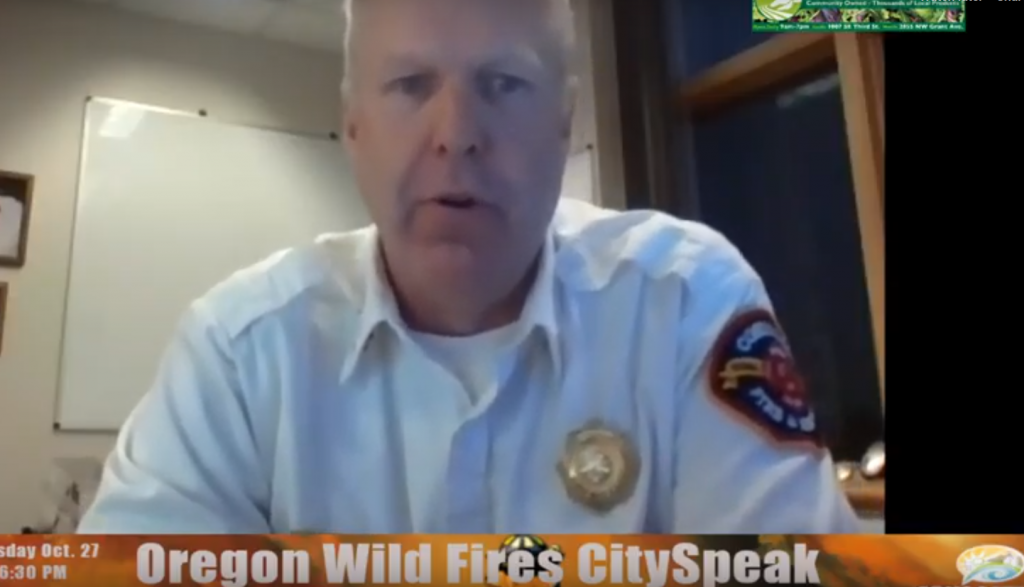 Are wildfire seasons worsening as the climate changes? What roles does the climate play in making human-caused fires more destructive? And what should be done in terms of forest management?
Are wildfire seasons worsening as the climate changes? What roles does the climate play in making human-caused fires more destructive? And what should be done in terms of forest management?
These topics are at the root of the discussion in The Advocate’s most recent CitySpeak Forum. Panelists included professor John Bailey of OSU’s College of Forestry, Corvallis Fire Chief Ken McCarthy, and OSU College of Forestry associate professor Daniel Leavell.
According to the Insurance Information Institute, at least 230,000 acres have burned in Oregon this year and 40,000 residents were displaced. The same organization said Oregon is among the 10 states most at risk for wildfires.
McCarthy noted that as more Americans move from the cities to rural and suburban areas, the challenges for firefighters increase, not just in terms of logistics, but also in tax-based funding. He suggested thorough preparation for the event of fire such as creating defensible space around homes and preparing multiple evacuation routes. He added to that having ‘go-bags’ ready, having a meeting place known by family members, and knowing where to get information and updates were essential to fire preparedness.
With an annual budget of around $15.8 million for fire services in Corvallis, McCarthy listed a number of duties for his department outside of firefighting such as ambulance services, hazardous materials responses, swift-water and confined-space rescue operations, and other tasks requiring manpower and equipment. He highlighted the use of police and fire utility fee revenue to grow from 12 to 16 firefighters on daily duty, allowing for two dedicated ambulances. This would keep fire engines from needing to switch over to medical calls.
In terms of public safety, the fire chief advocated for federal legislation mandating sprinkler-style fire alarms in new residential and commercial construction, saying the best firefighter in nearly any scenario except for wildfire is a sprinkler system. While the systems are expensive and push up housing costs, McCarthy said the investment is worthwhile.
“Sprinklers are on scene when the fire starts,” McCarthy said. “But that’s going to be a big fight with some people opposed to the cost.”
Bailey said Oregon’s wildfires have become increasingly damaging, particularly the larger fires, including this year’s record-setting blazes. He said three of the four past years have been Oregon’s biggest fire seasons on record, with 2019 being a small respite. But by any measurement used – burned acres, dollars spent, staff hours, suppression costs, damage – the problem is getting worse and has been for decades.
Three factors are driving the wildfire crisis, according to Bailey: warming climates leading to longer fire seasons, the accumulation of wildfire fuels as trees grow and die without close management such as controlled burning, and the increased human population. He cited an overlooked history of forest management through natural and controlled fires in Oregon.
Bailey rattled off a laundry list of the positive attributes of Oregon’s forest – natural resources, jobs, wildlife, recreation, spirituality – all these positive attributes are highly valued by Oregonians and visitors alike. But the forest is also fuel, and that means an inherent fire danger that is being proven in some of the biggest wildfires ever seen on the West Coast.
“We’ve gone through a phase where we kind of forgot about that fire history and the fuel side,” Bailey said. “My recommendation, always, is remember the fuel … it’s going to burn.”
Leavell has been part of an effort to build a fire program at the College of Forestry Extension for around five years. The state legislature granted funding this past June for the program to provide eight new positions to go into the community and teach fire science, maintenance and prevention, do risk assessments and mitigations, and other work. He said the legislature is fully supporting the effort to reduce fire risk.
“I don’t know of another program like it anywhere in the country, at any college or university,” Leavell said. “It’s that unique, and it’s tailored to not only provide education but outreach across the state … I don’t know of another extension program that has the agents on the ground, the specialists available across the state in forestry and natural resources.”
A former military firefighter with a long resume of fire-involved work, Leavell has been involved with fire responses since 1969. In that time, he’s seen what happens when forests aren’t managed and when home fire defense is not enacted (it could be as simple as fire detectors and extinguishers). He’s concerned about the intersection of bigger fires and more people, a mixture prone to disaster.
Leavell said in terms of size, what constitutes a major wildfire has jumped up from 10,000 acres in the early 70s, to 100,000 acres in the 80s, and now a million acres burning is considered significant. He said fires are getting harder to put out as the climate warming continues, adding that the past seven years were the hottest on record, and that 2020 is shaping up as the hottest yet.
By Cody Mann
Do you have a story for The Advocate? Email editor@corvallisadvocate.com



